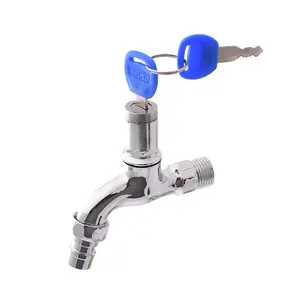
Golden CUPC Kitchen Faucet Spring Pull Down Dual Outlet Spouts 360 Swivel Handheld Shower Kitchen Mixer


Factory Wholesale Zinc Alloy Washing Machine Faucet Polished Chrome Portable Faucets Home User External Lock Anti-Theft Tap























The outdoor faucet plays a pivotal role in facilitating various outdoor activities that involve water. Positioned on the exterior of a building, the outdoor faucet serves as a convenient and accessible source of water for tasks ranging from watering the garden to washing the car.
One common type of outdoor faucet is the freeze-proof faucet, designed to withstand colder temperatures without the risk of freezing and damaging the plumbing. The freeze-proof faucet features a long valve stem that extends into the heated interior of the building. When the faucet is turned off, the water in the pipe drains back into the building, preventing freezing in the exposed section of the pipe. This design ensures that the outdoor faucet remains functional even in colder climates, where freezing temperatures can pose a threat to plumbing. The outdoor faucet is a key component of a home's water supply system, providing a direct connection to the water mains. Its location on the exterior of a building allows for easy access, eliminating the need to run hoses or buckets from inside the house for outdoor chores. This accessibility makes the water spigot a practical and time-saving feature for homeowners and gardeners alike.
The outdoor spigot is often equipped with a threaded outlet, allowing for the easy attachment of hoses or other watering devices. This versatility makes the outdoor spigot a central point for various outdoor water-related activities. Whether it's connecting a garden hose for lawn irrigation or attaching a pressure washer for cleaning tasks, the outdoor spigot serves as a versatile hub for water access in outdoor spaces. The design of the outdoor water faucet is typically straightforward, consisting of a valve mechanism that controls the flow of water. The valve is operated by a handle or lever, allowing users to turn the water on or off easily. Some outdoor faucets may also feature additional features, such as a built-in backflow preventer, which helps prevent the contamination of the water supply.
Maintaining the outdoor faucet is essential to ensure its proper functionality and longevity. Regular checks for leaks, drips, or any signs of damage are crucial in preventing water wastage and potential damage to the surrounding area. Additionally, protecting the hose spigot from extreme weather conditions, especially during winter, is important to prevent freezing and subsequent damage to the plumbing.
When choosing an exterior water faucet, factors such as material and design should be considered. Brass and stainless steel are popular choices for outdoor faucets due to their durability and resistance to corrosion. The design of the faucet should also align with the intended use and the aesthetics of the outdoor space. Whether opting for a traditional knob-style faucet or a more modern lever design, the goal is to find a faucet that meets functional needs while complementing the overall outdoor environment. In addition to serving practical purposes, the hose spigot can be integrated into landscaping plans to enhance the aesthetic appeal of outdoor spaces. Concealing the faucet with decorative covers or incorporating it into garden features can contribute to a more visually pleasing outdoor environment. This approach allows homeowners to blend the functional aspects of the outdoor faucet seamlessly with the overall design of their outdoor spaces.